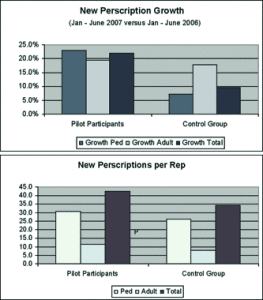Improving Market Performance By Giving Customers What They Want
Company
Specialty products group within a Fortune 25 US-based global pharmaceuticals firm.
Situation
Under the best circumstances, differentiating a commoditized product with a competitor-shared formulation in the highly regulated pharmaceutical industry is no easy feat. Throw in a set of strict internally imposed compliance guidelines that limit customer sales inducements and the challenge becomes downright daunting.
That’s the situation this pharmaceutical group found themselves in after a competitor was handed a $500M legal judgment for improperly attempting to influence their customers’ purchase decisions.
Our Philosophy
Many businesses are hesitant to become more “customer focused” without proof that doing so will yield predictable results for their company. We believe in overcoming this roadblock by designing strategies that produce measurable business results.
Our Role
After assessing the situation, it was clear they were locked into the traditional pharmaceutical sales model: send an army of reps into physicians’ offices with product literature and samples. It was also quite clear they had a limited understanding of why physicians chose or failed to choose their product over others.
We conducted a series of strategic workshops to explore what they knew and did not know about their customers. Then, we linked our work to their existing attitude and usage research to fill the gaps. This research revealed one particularly striking observation: a significant percentage of their customers simply wanted to be left alone!
We recommended a dramatic change in selling approach: from a “push” model (talking “at” customers) to one based on prospect/customer’s stated preferences (“how can we help you be more successful?”). Not surprisingly, such a dramatic change to their traditional sales model was met with trepidation (complicated by the concern that “helping customers be more successful” might be considered “inducement” under their compliance rules).
We convinced them to run a pilot using 20% of their field reps (chosen randomly to ensure unbiased results). The pilot involved:
- Creating sales literature that focused on the needs of the physician rather than the features of the product/services being sold.
- Getting the materials approved by their compliance department (explaining the difference between “inducement” and “responding to customer needs”).
- Training the reps (and their managers) to effectively use the material (including role plays and ride-alongs to balance the need for compliance with the need for effectiveness).
- Setting up metrics to measure the results.
Result
The attached graphs (included here with the client’s permission) show the results of the pilot on prescriptions written and year-to-year percentage growth basis.
Clearly, the customer responsive selling strategy delivered substantially improved results. The sales organization has now trained the rest of their reps to the new model. They report a 20% increase in new prescriptions versus last year. Moreover, the company is beginning to use this approach more broadly throughout the organization, fundamentally transforming the way they go to market.
